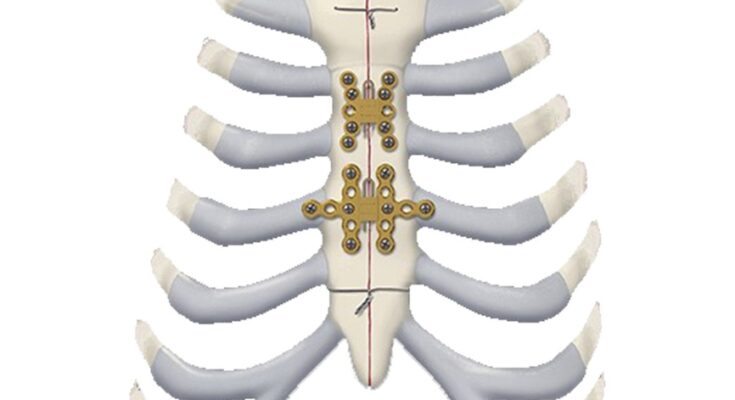In 2021, the market for Sternal Closure Systems worldwide was worth $2.60 billion US dollars. AMR Group projects that the market will reach US$ 4.2 billion by 2031, growing at a CAGR of 6.4 percent between 2022 and 2031.
Industry Overview
Sternal closure systems are medical devices used to close the sternum (breastbone) after a sternotomy, which is a surgical procedure that involves cutting through the sternum to access the heart or other organs in the chest. Sternal closure systems are used to hold the two halves of the sternum together and promote healing after the sternotomy. Sternal closure systems consist of a variety of devices, including wires, plates, screws, and cable systems. These devices are designed to provide stable fixation of the sternum while minimizing pain and discomfort for the patient. The choice of sternal closure system depends on the patient’s condition, the surgeon’s preference, and the type of surgery being performed.
Sternal closure systems are commonly used in cardiac surgery, including coronary artery bypass grafting (CABG), valve replacement, and heart transplant surgery. They are also used in thoracic surgery, such as lung resection and esophagectomy. Effective sternal closure is critical for postoperative recovery and patient outcomes. Sternal dehiscence (separation of the sternum) is a serious complication that can lead to infection, delayed healing, and even death. The use of sternal closure systems has been shown to reduce the incidence of sternal dehiscence and improve patient outcomes after sternotomy.
Market Dynamics
The global sternal closure systems market is primarily driven by the increasing incidence of cardiac and thoracic surgeries, as well as the growing demand for minimally invasive surgical procedures. Here are some of the key market dynamics:
Increasing incidence of cardiac and thoracic surgeries: The rising prevalence of cardiovascular diseases and the growing aging population are driving the demand for cardiac and thoracic surgeries. According to the American Heart Association, approximately 2.4 million CABG procedures are performed worldwide each year. Sternal closure systems are an essential component of these surgeries, driving the demand for these devices.
Growing demand for minimally invasive surgical procedures: The increasing demand for minimally invasive surgical procedures is driving the development of new sternal closure systems. These devices allow for smaller incisions and reduced tissue trauma, resulting in faster recovery times and lower risk of complications. Minimally invasive surgical procedures also provide cost savings for healthcare providers, which is driving the adoption of these procedures.
Get Free Exclusive PDF Sample Copy of This Research: https://analyticsmarketresearch.com/sample-request/sternal-closure-systems-market/17071/
Technological advancements in sternal closure systems: Advancements in sternal closure systems are driving the market growth. Manufacturers are developing new products that offer improved stability, faster healing times, and reduced risk of complications. For instance, some of the latest sternal closure systems use absorbable materials, reducing the need for hardware removal and potentially reducing the risk of infection.
High cost of sternal closure systems: The high cost of sternal closure systems is a major challenge in the market. These devices are often expensive, making them inaccessible to patients who cannot afford them. Additionally, the cost of sternal closure systems can be a barrier for healthcare providers, limiting their adoption of these devices. Overall, the sternal closure systems market is expected to continue to grow in the coming years, driven by the increasing demand for cardiac and thoracic surgeries, the growing adoption of minimally invasive surgical procedures, and technological advancements in sternal closure systems. However, the high cost of these devices remains a significant challenge in the market.
COVID Impact
The COVID-19 pandemic has had a significant impact on the sternal closure systems market, both positive and negative. Here are some of the ways the pandemic has affected the market: Reduced demand for elective surgeries: The COVID-19 pandemic has led to a reduction in elective surgeries, including cardiac and thoracic surgeries. This has resulted in a decline in the demand for sternal closure systems.
Increased demand for critical care resources: The COVID-19 pandemic has also led to an increased demand for critical care resources, including hospital beds and ventilators. This has resulted in a shift of resources away from elective surgeries, further reducing the demand for sternal closure systems.
Accelerated adoption of minimally invasive surgeries: With the need to reduce the risk of infection and conserve resources, there has been an accelerated adoption of minimally invasive surgical procedures. This has led to increased demand for sternal closure systems that are compatible with these procedures.
Growth in telemedicine: The COVID-19 pandemic has also led to a growth in telemedicine, with healthcare providers using virtual consultations to reduce the risk of infection. This has resulted in an increased demand for sternal closure systems that can be easily monitored remotely. Overall, the COVID-19 pandemic has had a mixed impact on the sternal closure systems market. While there has been a reduction in the demand for elective surgeries, there has also been an accelerated adoption of minimally invasive surgeries and growth in telemedicine, which is driving the demand for sternal closure systems that are compatible with these new procedures and technologies.
Regional Trend
The sternal closure systems market can be analyzed regionally as follows:
North America: North America is the largest market for sternal closure systems, owing to the high prevalence of cardiovascular diseases and the growing demand for minimally invasive surgical procedures. The presence of key market players in the region, along with favorable reimbursement policies, is also driving the market growth.
Europe: Europe is another significant market for sternal closure systems, driven by the increasing adoption of minimally invasive surgical procedures, advancements in healthcare infrastructure, and growing healthcare expenditure. The region also has a well-established healthcare system and favorable reimbursement policies, which is driving the market growth.
Asia-Pacific: The Asia-Pacific region is expected to witness significant growth in the sternal closure systems market due to the increasing prevalence of cardiovascular diseases, growing aging population, and improving healthcare infrastructure. The rising demand for minimally invasive surgical procedures and advancements in healthcare technologies are also driving the market growth.
Latin America: The Latin America region is expected to witness moderate growth in the sternal closure systems market due to the increasing adoption of minimally invasive surgical procedures, growing healthcare expenditure, and improving healthcare infrastructure.
Middle East and Africa: The Middle East and Africa region is expected to witness slow growth in the sternal closure systems market due to the limited healthcare infrastructure and the low adoption of advanced healthcare technologies. Overall, the sternal closure systems market is expected to witness significant growth in the coming years, driven by the increasing prevalence of cardiovascular diseases, growing aging population, and advancements in healthcare infrastructure and technologies.
Competitive Landscape
The global sternal closure systems market is highly competitive, with several established players as well as new entrants competing for market share.
Some of the key players in the market include:
Zimmer Biomet Holdings Inc.
A&E Medical Corporation
KLS Martin Group
Depuy Synthes (Johnson & Johnson)
Orthofix Medical Inc.
Acute Innovations LLC
IDEAR S.R.L.
Kinamed Incorporated
Abyrx Inc.
Medline Industries Inc.
These companies are focusing on various strategies such as product launches, mergers and acquisitions, partnerships, and collaborations to expand their market presence and increase their revenue share. For instance, in January 2021, Zimmer Biomet announced the launch of its X-ROS™ system for sternotomy closure, featuring a new sternal closure device and cable tensioning system.
In addition, companies are also focusing on the development of new and innovative sternal closure systems to stay ahead of the competition. For example, KLS Martin Group launched its Sternal ZipFix® in 2019, a system that offers a less invasive and less traumatic approach to sternal closure. The increasing focus on minimally invasive surgical procedures is also driving the competition in the market, with companies developing sternal closure systems that are compatible with these procedures. For instance, Acute Innovations LLC offers a range of minimally invasive sternal closure devices that are designed to reduce surgical time and complications. Overall, the competitive landscape of the sternal closure systems market is characterized by intense competition, with companies focusing on innovation, product development, and strategic partnerships to gain a competitive edge.
Market Segmentation
The sternal closure systems market can be segmented based on product type, material type, procedure type, end-user, and region:
By Product Type:
Closure Devices: Includes wires, plates, and screws
Closure Tools: Includes needle holders, forceps, and retractors
By Material Type:
Stainless Steel
Titanium
Absorbable Materials
Others
By Procedure Type:
Open Heart Surgery
Minimally Invasive Surgery
By End-User:
Hospitals
Specialty Clinics
Ambulatory Surgical Centers
By Region:
North America
Europe
Asia-Pacific
Latin America
Middle East and Africa
The closure devices segment is expected to hold the largest share of the sternal closure systems market due to their wide usage in cardiac surgeries. The absorbable materials segment is also expected to witness significant growth due to their advantages over non-absorbable materials, such as reducing the need for removal. The minimally invasive surgery segment is expected to witness significant growth due to the growing demand for less invasive procedures and shorter hospital stays. Hospitals are expected to hold the largest share of the end-user segment, owing to the high number of cardiac surgeries performed in hospitals. Regionally, North America is expected to hold the largest share of the market due to the high prevalence of cardiovascular diseases and the presence of key market players in the region. The Asia-Pacific region is expected to witness significant growth due to the increasing prevalence of cardiovascular diseases and improving healthcare infrastructure in the region.
Global Sternal Closure Systems Market: Market Size Estimation
Both the top-down and bottom-up approaches were used to estimate and validate the size of the market and to estimate the size of various other dependent sub-markets of various marketspaces. The key players in the markets are identified through secondary research, and their market contributions in different applications across regions and globally were determined through primary and secondary research. This entire process included the study of the annual and financial reports of the top market players and extensive interviews for key insights with industry leaders such as CEOs, VPs, directors, and marketing executives. All percentage shares, splits, and breakdowns were determined using secondary sources and verified through primary sources. All the possible parameters that affect the market covered in this research study have been accounted for, viewed in extensive detail, verified through primary research, and analysed to arrive at the final quantitative and qualitative data. This data has been consolidated, and detailed inputs and analysis from Analytics Market Research added before being presented in this report.
To Know More, Click here: https://analyticsmarketresearch.com/reports/sternal-closure-systems-market/17071/
Frequently Asked Questions
• What is the market size and growth projections?
• What is the market size and growth projection for each of the market segments and sub-segments across Countries & Regions?
• What are the top performing segments, and countries / regions of each of the markets?
• What is the market size and growth rate across key countries / regions?
• How big is the global & regional market in terms of revenue and volume?
• How far market will grow in forecast period in terms of revenue and volume?
• What factors will influence demand and supply trends across each markets during the forecast period?
• What are the technology trends shaping various markets?
• Which country / region has more opportunities?
• What is the COVID-19 impact on the market and how long will it take to recover?
• Who are the key competitors of market Players?
• What are the market share (%) of Key Players?
• What are the Merger & Acquisition, New Product Launch, Recent Development within each of the Markets?
• What are PEST analysis, Ecosystem Analysis, Porter’s Five Forecast Analysis, Ansoff Matrix, and SWOT Analysis among other analyses for diverse markets?




